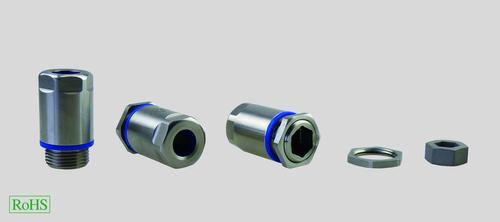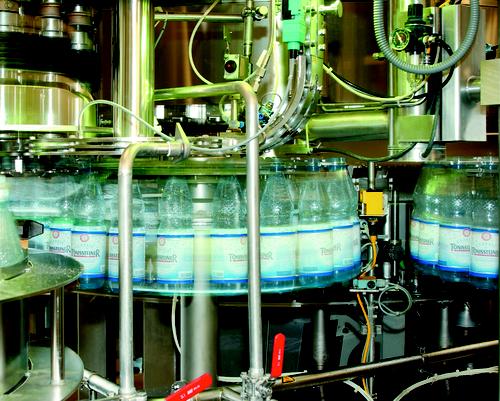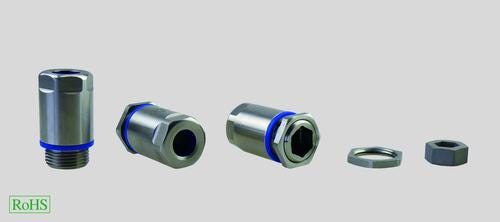Ecolab-Tested Cable Jacket for Washdown Applications
March 2, 2015

The standards electrical machines and components are required to meet in the food processing industry are far more stringent than those in traditional plant construction. For specialized production environments such as these, components must not only resist thermal and physical stresses, they must also be resistant to the chemicals used to sterilize equipment.
Health and safety might be only the second most important aspect of food products for consumers, after flavor, but food quality is just as important. When it comes to ensuring food safety and avoiding potential food epidemics, strict standards are placed on plants and machinery. The VDMA, a leading German engineering association, estimates washdown time in the food industry to be between 20% and 30& of overall production time.
Direct or indirect contact determines the standard
In hygienically complex applications such as those found in the food or pharmaceuticals industries, a distinction must be made between components that have direct contact with foodstuffs and those that are positioned in the vicinity of machinery, or indirect contact. The former are subject to even more stringent guidelines than those that do not come into contact with food and are required to satisfy additional standards, such as those of the Food and Drug Administration (FDA).

The latter must withstand high-pressure cleaning with water and the appropriate chemicals during regularly scheduled "full-facility" cleanings, which all plants must undergo. This process consists of spraying down the entire industrial plant to remove any bacteria or other microorganisms that may have formed during the production stage. These automated cleaning processes are referred to as clean-in-place (CIP) or steam-in-place (SIP) operations, as the case may be. To ensure that even the smallest surfaces are cleaned, plants and their machinery must be fully accessible. A machine's subcomponents must also be removed quickly and easily for thorough equipment sanitation.
For applications involving strict hygienic and antiseptic guidelines, more and more component manufacturers in the field of drive technology are developing sensory systems, such as electric cables, that can be classified as washdown products. These products are designed not to become soiled, which prevents bacterial growth. They are developed around the principles of having smooth surfaces, avoiding dead space, and using stainless steel and other specially coated construction materials.
Food plants, with their numerous systems and components, must not only be kept clean easily, they must be resistant to the cleaning agents themselves. To stay ahead of future customer demand, cable manufacturers should get their cables tested and approved by chemical manufacturers. HELUKABELchose to have its products tested and approved by Ecolab.

Polyurethane blend withstands Ecolab testing
Since 1923, Ecolab has been setting the industrial standard in professional cleaning and disinfection. The company offers all-inclusive hygiene solutions for the industrial, public institution and healthcare markets. The material resistance test that Ecolab conducted was configured based on the material used in the cable's outer jacket.
A polyurethane (PUR) mixture used to protect hygienic power and data cables was chosen for this test. The cables using this PUR compound have displayed excellent cleaning characteristics and shown resistance to all common acidic and alkaline cleaners and disinfectants. In certain cases, such as customers asking for an antibacterial outer jacket material, this PUR compound incorporates additives that yield a material blend that prevents contaminants and microorganisms from settling on the jacket.
The Ecolab test was performed with various cleaning and disinfecting agents for the food and beverage industry: an alkaline cleaner and disinfectant with active chlorine (P3-topax 66), an acidic foam cleaning agent (P3-topax 52), an alkaline, chlorine-free foam cleaner (P3-topactive 200), and an acidic foam disinfectant with a peroxyacid basis (P3-topactive Okto) plus de-mineralized water as a zero value. A cable with the PUR outer jacket was submerged in each test medium for 28 days at constant room temperature. Both a visual inspection and mechanical tests were then conducted to detect any swelling, cracks, color changes, or changes to the surface characteristics, dimensions and mechanical properties when compared to measurements taken before the washdown tests started.
The results of the visual inspection and mechanical tests showed that the jacket material successfully withstood the Ecolab washdown procedure. Not only that, it is a neutral color and approved for high-speed cable tracks, as well.
Furthermore, the test followed a prescribed cleaning plan, which exists for all food-processing plants and sets out precisely what the procedure comprises, from pre-washing to foaming to rinsing.
FDA conformity without UL certification and vice versa
The last year-and-a-half has shown an increased interest in FDA-compliant cables, which is a topic of considerable complexity. The FDA specifies that cables used in food production plants must be made of plastics that display particular characteristics. For instance, they must not contain any hazardous substances such as flame retardants or other additives. This, however, goes against the requirements needed for UL product certification.
The underlying FDA standard describes the admissible plastic materials for repeated or constant use in food applications. With FDA-compliant materials such as polypropylene (PP), UL certification is almost unattainable, since the required flame-resistance characteristics of the cables are difficult to achieve, if at all. By not incorporating additives such as flame retardants, it is virtually impossible for PP materials to pass fire tests conducted in accordance with UL specifications pursuant to UL 94 V-0.
UL certification is essential for bringing a product into the American market. Under the present conditions, customers must choose between UL certification and FDA compliance. Having certification from chemical manufacturers, like Ecolab, to provide end customers is a compromise and shows that they can rely on the continued performance of a cable's mechanical properties when using standard cleaning and disinfecting agents.
In addition to having cables and wires capable of withstanding washdown processes, it's important to have hygienic accessories such as cable glands, protective conduit and stainless steel hose fittings. All three should have smooth surfaces that prevent dangerous organisms from taking hold and enable easy, fast and inexpensive cleaning. Resistance to damage from sterilization using high-pressure cleaning equipment is recommended. Moreover, they should resist chemical cleaning agents, prevent the formation of contaminants, and prevent foreign bodies from penetrating the casing.
Thomas Pikkemaat is drive technology product manager for HELUKABEL.
About the Author(s)
You May Also Like





